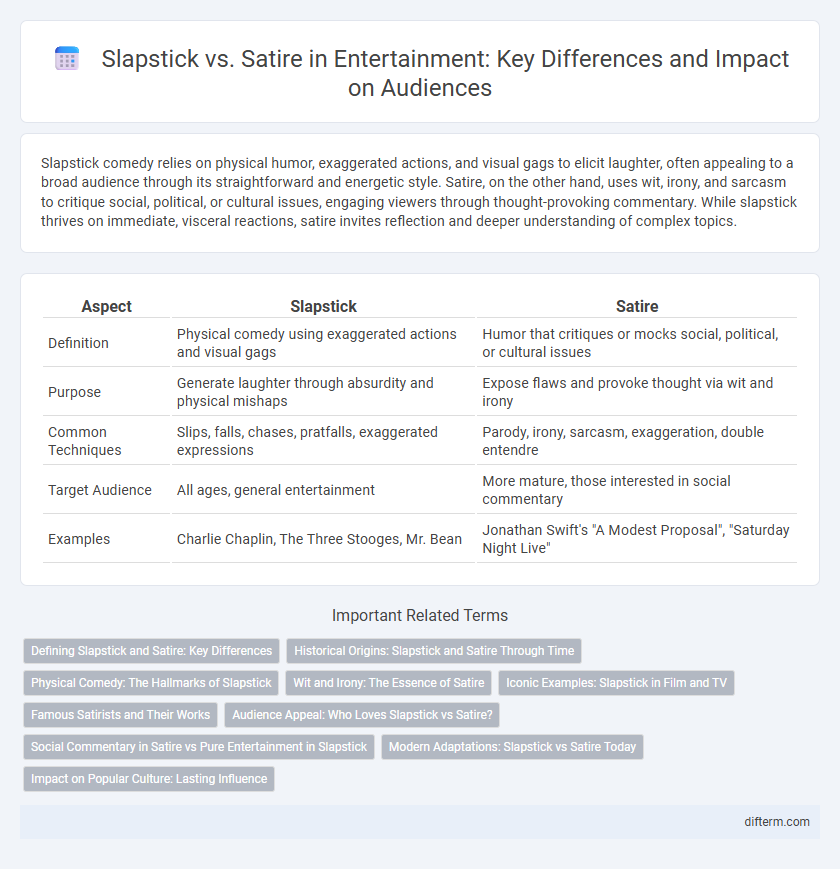Slapstick comedy relies on physical humor, exaggerated actions, and visual gags to elicit laughter, often appealing to a broad audience through its straightforward and energetic style. Satire, on the other hand, uses wit, irony, and sarcasm to critique social, political, or cultural issues, engaging viewers through thought-provoking commentary. While slapstick thrives on immediate, visceral reactions, satire invites reflection and deeper understanding of complex topics.
Table of Comparison
| Aspect | Slapstick | Satire |
|---|---|---|
| Definition | Physical comedy using exaggerated actions and visual gags | Humor that critiques or mocks social, political, or cultural issues |
| Purpose | Generate laughter through absurdity and physical mishaps | Expose flaws and provoke thought via wit and irony |
| Common Techniques | Slips, falls, chases, pratfalls, exaggerated expressions | Parody, irony, sarcasm, exaggeration, double entendre |
| Target Audience | All ages, general entertainment | More mature, those interested in social commentary |
| Examples | Charlie Chaplin, The Three Stooges, Mr. Bean | Jonathan Swift's "A Modest Proposal", "Saturday Night Live" |
Defining Slapstick and Satire: Key Differences
Slapstick comedy centers on exaggerated physical humor and absurd situations, relying heavily on visual gags and pratfalls to provoke laughter. Satire uses wit, irony, and sarcasm to critique social, political, or cultural issues by exposing hypocrisy and absurdity through clever commentary. While slapstick emphasizes physicality and immediate laughs, satire engages the audience intellectually by encouraging reflection on deeper societal themes.
Historical Origins: Slapstick and Satire Through Time
Slapstick comedy traces its origins to the Italian Renaissance Commedia dell'arte, featuring physical humor and exaggerated actions that captivated audiences with visual gags. Satire dates back to ancient Greece and Roman literature, where writers like Aristophanes and Juvenal used wit and irony to criticize social and political issues. Over centuries, slapstick evolved into physical theatrical performances, while satire developed into sophisticated literary and dramatic forms that provoke critical thinking.
Physical Comedy: The Hallmarks of Slapstick
Slapstick comedy relies heavily on exaggerated physical actions, such as pratfalls, chases, and unexpected collisions, to provoke laughter through visual humor. This form of comedy prioritizes timing and physical agility, creating a direct and immediate comic effect without the need for dialogue or intricate plots. Classic examples include the works of Charlie Chaplin and the Marx Brothers, where physicality serves as the primary vehicle for humor, contrasting sharply with the verbal wit and social critique central to satire.
Wit and Irony: The Essence of Satire
Satire thrives on sharp wit and layered irony to expose human follies and societal flaws, creating humor that provokes thought rather than just laughter. Unlike slapstick, which relies on physical comedy and exaggerated actions, satire uses clever language and subtle critique to engage audiences intellectually. This sophisticated interplay of irony and insight defines satire's enduring appeal in entertainment.
Iconic Examples: Slapstick in Film and TV
Charlie Chaplin's "The Tramp" series and the physical comedy of Lucille Ball in "I Love Lucy" remain iconic examples of slapstick in film and TV. The Keystone Cops' chaotic chases and Jim Carrey's exaggerated expressions in "Ace Ventura" highlight slapstick's emphasis on physical humor and visual gags. These examples showcase slapstick's enduring appeal through its reliance on exaggerated physicality and timing to evoke laughter.
Famous Satirists and Their Works
Famous satirists such as Jonathan Swift, Mark Twain, and George Orwell use wit and irony to critique societal norms and politics, as seen in works like "A Modest Proposal," "The Adventures of Huckleberry Finn," and "Animal Farm." Satire targets human vices and follies through subtle, clever humor, contrasting with slapstick's physical comedy and exaggerated actions. These satirical masterpieces influence modern entertainment by blending humor with powerful social commentary.
Audience Appeal: Who Loves Slapstick vs Satire?
Slapstick comedy captivates audiences who enjoy physical humor, exaggerated expressions, and fast-paced antics, often appealing to children and those seeking lighthearted entertainment. Satire attracts viewers who appreciate sharp wit, social criticism, and thought-provoking content, resonating with mature audiences interested in cultural and political commentary. Both genres engage different demographics by catering to distinct tastes in humor and intellectual stimulation.
Social Commentary in Satire vs Pure Entertainment in Slapstick
Satire uses humor as a tool for social commentary, critiquing societal norms, politics, and cultural issues through irony and exaggeration. Slapstick emphasizes physical comedy, relying on visual gags and exaggerated actions purely for entertainment without deep social analysis. The contrast highlights satire's role in provoking thought and reflection, while slapstick prioritizes immediate laughter and lighthearted amusement.
Modern Adaptations: Slapstick vs Satire Today
Modern adaptations of slapstick often rely on exaggerated physical comedy and visual gags, as seen in films like "The Pink Panther" series and TV shows such as "Mr. Bean." In contrast, contemporary satire uses sharp wit and irony to critique society, exemplified by programs like "The Daily Show" and "Black Mirror." Both genres remain influential in entertainment, adapting to digital platforms and evolving audience sensibilities.
Impact on Popular Culture: Lasting Influence
Slapstick comedy's exaggerated physical humor has shaped popular culture by inspiring iconic characters and timeless routines in film and television, consistently appealing to broad audiences with its universal visual gags. Satire drives social commentary through wit and irony, influencing public discourse and encouraging critical engagement with political and cultural issues in media. Both forms maintain lasting influence by continuously redefining humor's role in entertainment and shaping audience perceptions across generations.
slapstick vs satire Infographic

 difterm.com
difterm.com